Timeline of the 1972 Atlantic hurricane season

The 1972 Atlantic hurricane season is one of five Atlantic hurricane seasons not to have any major hurricanes, the others being 1968, 1986, 1994, and 2013. During the season, seven tropical or subtropical depressions formed, all of which became tropical or subtropical storms or hurricanes.[1] The season officially began on June 1, 1972 and ended on November 30. These dates typically limit the period of each year when most tropical cyclones form in the eastern Atlantic basin. This timeline documents all the storm formations, strengthening, weakening, landfalls, extratropical transitions, as well as dissipation. The timeline also includes information which was not operationally released, meaning that information from post-storm reviews by the National Hurricane Center, such as information on a storm that was not operationally warned on, has been included.
The first storm of the season, Subtropical Storm Alpha, formed on May 23, before the season began on June 1. The final storm of the season, Subtropical Storm Delta, dissipated on November 7. There were seven tropical cyclones during the season. Of these, three were subtropical storm, and four were tropical. Of these tropical systems, three became hurricanes; none of these reached Category 3 intensity or higher on the Saffir-Simpson hurricane scale. Although it was an inactive season, 1972 brought one of the deadliest and most expensive hurricanes to strike the United States, Hurricane Agnes. Agnes was a weak but large storm that made landfall at the Florida panhandle and then followed the east coast northward. It killed 122 people and caused $2.1 billion (1972 dollars) in damage, mostly due to flooding in Pennsylvania and New York.[1]
Timeline of storms

May
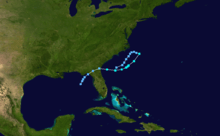
May 23
- 2:00 p.m. EDT (1800 UTC) – A subtropical depression forms while located to the southeast of Savannah, Georgia.[2][3]
May 25
May 26
- 6:00 a.m. EDT (1200 UTC) – Subtropical Storm Alpha reaches its maximum sustained winds of 70 mph (110 km/h).[2][3]
- 8:00 p.m. EDT (0000 UTC May 27) – Subtropical Storm Alpha makes landfall near Brunswick, Georgia with winds of 45 mph (75 km/h).[2][3]
May 28
May 29
- 6:00 a.m. EDT (1200 UTC) – Subtropical Depression Alpha dissipates in the northern Gulf of Mexico[2][3]
June
June 1
- The 1972 Atlantic hurricane season officially begins.[4]
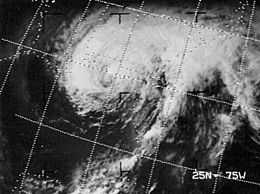
June 14
June 15
- 1:00 p.m. CDT (1800 UTC) – The tropical depression emerges off the Yucatan Peninsula into the western Caribbean Sea with winds of 35 mph (55 km/h).[5][6]
June 16
June 18
June 19
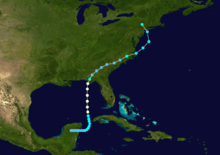
- 1:00 p.m. CDT (1800 UTC) – Hurricane Agnes makes landfall near Panama City, Florida with winds of 75 mph (120 km/h).[5][6]
- 7 p.m CDT (0000 UTC) – Hurricane Agnes weakens into a tropical storm.[5][6]
June 20
June 21
- 2:00 p.m. EDT (1800 UTC) – Tropical Depression Agnes unexpectedly re-strengthens into a tropical storm while over eastern North Carolina.[5][6]
- 8:00 p.m. EDT (0000 UTC) – Tropical Storm Agnes emerges into the Atlantic Ocean near Nags Head, North Carolina.[5][6]
June 22
June 23
July
There were no tropical systems during the month of July in the Atlantic hurricane basin.
August

August 22
August 23
August 25
August 27
August 27
August 29
- 8:00 a.m. EDT (1200 UTC) – A tropical depression forms to the west of Daytona Beach, Florida.[9][10]
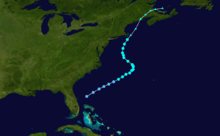
August 30
August 31
September
September 1
September 3

September 4
- 8:00 p.m. EDT (0000 UTC September 5) – A tropical depression forms northeast of Santa Clara, Cuba.[11][12]
September 5
- 2:00 p.m. EDT (1800 UTC) – The tropical depression crosses Key Largo, Florida and the Florida Panhandle with winds of 35 mph (55 km/h).[11][12]
- 8:00 p.m. EDT (0000 UTC) – The tropical depression emerges off the Florida Panhandle.[11][12]
September 6
September 7
September 8
September 12
September 14
- 8:00 a.m. EDT (1200 UTC) – Tropical Depression Dawn dissipates northeast of Charleston, South Carolina after having paralleled the Georgia and South Carolina coasts for the last 24 hours.[11][12]

September 19
September 19
September 20
September 21
October
- No tropical cyclones formed in the Atlantic Ocean during the month of October.
November
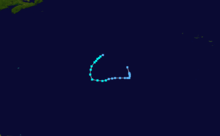
November 1
November 2
November 4
November 7
November 30
- The 1972 Atlantic hurricane season officially ends.[4]
See also
References
- ↑ 1.0 1.1 "Season Summary for 1972" (PDF). US Weather Service. Retrieved 2009-01-29.
- ↑ 2.0 2.1 2.2 2.3 2.4 2.5 2.6 "Subtropical Storm Alpha Best Track". Tropical Prediction Center. Retrieved 2009-01-28.
- ↑ 3.0 3.1 3.2 3.3 3.4 3.5 3.6 "HURDAT Best Track for Subtropical Storm Alpha". Atlantic Basin Hurricane Database. Retrieved 2009-01-29.
- ↑ 4.0 4.1 Atlantic Oceanographic and Meteorological Laboratory, Hurricane Research Division. "Frequently Asked Questions: When is hurricane season?". National Oceanic Atmospheric Administration. Retrieved 2008-08-21.
- ↑ 5.0 5.1 5.2 5.3 5.4 5.5 5.6 5.7 5.8 5.9 5.10 5.11 5.12 "Hurricane Agnes Best Track". Tropical Prediction Center. Retrieved 2009-01-28.
- ↑ 6.0 6.1 6.2 6.3 6.4 6.5 6.6 6.7 6.8 6.9 6.10 6.11 6.12 "HURDAT Best Track for Hurricane Agnes". Atlantic Basin Hurricane Database. Retrieved 2009-01-29.
- ↑ 7.0 7.1 7.2 7.3 7.4 7.5 7.6 7.7 7.8 "Hurricane Betty Best Track". Tropical Prediction Center. Retrieved 2009-01-28.
- ↑ 8.0 8.1 8.2 8.3 8.4 8.5 8.6 8.7 8.8 "HURDAT Best Track for Hurricane Betty". Atlantic Basin Hurricane Database. Retrieved 2009-01-29.
- ↑ 9.0 9.1 9.2 9.3 9.4 "Tropical Storm Carrie Best Track". Tropical Prediction Center. Retrieved 2009-01-28.
- ↑ 10.0 10.1 10.2 10.3 10.4 "HURDAT Best Track for Tropical Storm Carrie". Atlantic Basin Hurricane Database. Retrieved 2009-01-29.
- ↑ 11.0 11.1 11.2 11.3 11.4 11.5 11.6 11.7 11.8 "Hurricane Dawn Best Track". Tropical Prediction Center. Retrieved 2009-01-29.
- ↑ 12.0 12.1 12.2 12.3 12.4 12.5 12.6 12.7 12.8 "HURDAT Best Track for Hurricane Dawn". Atlantic Basin Hurricane Database. Retrieved 2009-01-29.
- ↑ 13.0 13.1 13.2 13.3 "Subtropical Storm Charlie Best Track". Tropical Prediction Center. Retrieved 2009-01-29.
- ↑ 14.0 14.1 14.2 14.3 "HURDAT Best Track for Subtropical Storm Charlie". Atlantic Basin Hurricane Database. Retrieved 2009-01-29.
- ↑ 15.0 15.1 15.2 15.3 15.4 "Subtropical Storm Delta Best Track". Tropical Prediction Center. Retrieved 2009-01-29.
- ↑ 16.0 16.1 16.2 16.3 16.4 "HURDAT Best Track for Subtropical Storm Delta". Atlantic Basin Hurricane Database. Retrieved 2009-01-29.